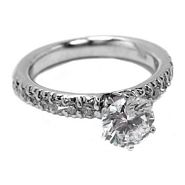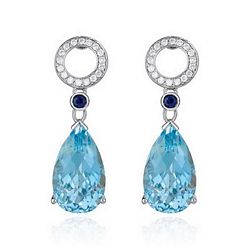Everything You Need To Know About
|
Diamond ShapesAsscher Diamonds A square diamond cut named after its inventor, Joseph Asscher.
Baguette Cut Diamonds A step cut in the shape of a small rectangular stone. May be tapered at one end.
Cushion Cut The Cushion cut diamond is an antique cut and is also referred to as Pillow cut or the Candlelight diamond. Cushion cut diamonds have larger facets and rounded corners than most cuts so as to increase their sparkle under candlelight.
Emerald Diamonds The Emerald Cut is rectangular with cut corners. It is a step cut as opposed to a brilliant cut. The facets are broad with flat planes resembling the steps of a stair. That's why it is referred to as a "step" cut. Unlike the Marquise brilliant, there is no bow-tie effect on an Emerald cut.
Heart Diamonds The Heart Shaped Brilliant bears some similarity to the Pear Shape, except that there is a cleft at the top. In fact, often the reason cutters may choose a Heart shape over a Pear may be that the Rough Diamond contained an inclusion located in the cleft. The skill of the cutter can make a great difference in the beauty of this cut. The "Shape Appeal" is especially important with Hearts.
Marquis diamonds The name "Marquise" came from a legend of the Marquise of Pompadour that the Sun King wanted a Diamond to be polished into the shape of the mouth of the Marquise! The typical Marquise Brilliant contains 56 facets.
Old European Cut Old European Cut diamonds used to be popular before the science of Diamond cutting developed the Round Brilliant Cut, which is designed to return more light to the eye.
Oval DiamondsThe Oval Shaped Brilliant is very similar to a Round except it is elliptical. It was invented by Lazare Kaplan in the early 1960s. The Oval brilliant usually has 56 facets. "Shape Appeal" is very important with Oval brilliants.
Pear Diamonds The Pear Shaped Brilliant is a combination of a Round brilliant and a Marquise cut. Pendants looks very nice set with a Pear shape as earrings, due to the "Teardrop" shape.
Princess Diamonds The Princess Cut is relatively new. It is a very attractive cut. Some people like the Princess because it is rectangular and yet has some of the sparkle of a Round brilliant cut.
Radiant Diamonds The radiant cut diamond,
invented by Henry Grossbard, is cut in the shape of a rectangle with rounded corners. Radiant
cut diamonds facets are cut into a pattern that gives this diamond the unique appearance of
cracked ice. Round DiamondsRounds are the most popular Shape that Diamonds are cut into. It is also the most brilliant of all the cuts. |
What You Should Know About Diamond Shapes and Cuts
Two diamonds that are the same shape will appear to look slightly different depending on the size and weight of the diamond, as well as the type of setting that the stone is placed in. The same ring worn on two different hands can also look quite different, based on the size of the hands.
Most Popular Diamond Shape for Engagement Rings
Even though there are a wide variety of diamond shapes available, as we stated previously. the most commonly
purchased diamond shape for engagement rings is the round diamond.
Round diamonds are considered the “classic engagement ring”, and the stones are often set in yellow gold or platinum. In fact, any diamond shape other than round is considered to be a “fancy” shape, since the round diamond is so popular.
Source: Vicente Ross, DiamondExperts.biz
Diamonds Are Forever
Buying Diamonds Guide | Diamond Rings | Diamond Earrings | Diamond Engagement Ring
Wedding Rings | Black Diamonds | Blue Diamond Ring | Diamond Bracelet | Tiffany Diamonds
Loose Diamonds | Fake Diamonds | Famous Diamonds | Bonded Diamonds | Colored Diamonds
Wholesale Diamonds | Platinum Wedding Ring | Diamond Solitaire Ring | Yellow Diamonds
Diamond Jewelry Resources
Jewelers Vigilance Committee | Gemological Institute of America | The Jewelers Board of Trade
American Institute Of Diamond Cutting
|
Blood Diamonds |
Stop Blood Diamonds
Join Stop Blood Diamonds |
Diamond Glossary |
Diamond FAQs |
Diamond Mine
The 4 C's of Diamonds | Diamond
Appraisal | Diamond Certificate
Fine Jewelry Resources
How To Find a
Great Jewelry Repair Shop | How To a Avoid Jewelry Repair
Fiasco | The Jewelry Repair
Guide
Man Made Diamonds
Apollo Diamond | CARAT
| Cubic Zirconia | Diamond Nexus |
Gemisis Cultured Diamond
Moissanite Jewelry | Russian
Diamonds | Swarovski Crystals |White
Sapphire
DIAMONDEXPERTS.BIZ is the leading diamond jewelry and fine jewelry resource on the Internet. We
provide up to date information on all types of diamonds and associated jewelry. Our primary mission is to help you
find the best deal possible on genuine diamond jewelry.
Copyright © Diamond Experts 1997-2012 All Rights Reserved.
Privacy Policy
Powered by the Buy Jewelry
Online
Diamond Experts
Diamond Cutters and Polishers, Goldsmiths, Top-Tier Designers and Diamond
Setting Masters
Antwerp Jewels & Diamond
Manufacturers
Antwerp / Belgium / Brazil / Canada / Europe / Italy / USA and
Worldwide



 Facebook
Facebook Twitter
Twitter Delicious
Delicious Livejournal
Livejournal Reddit
Reddit Stumbleupon
Stumbleupon Yahoo My Web
Yahoo My Web Google Bookmarks
Google Bookmarks BlinkList
BlinkList Digg
Digg Blogmarks
Blogmarks Diigo
Diigo Fark
Fark Ma.gnolia
Ma.gnolia Netvouz
Netvouz Newsvine
Newsvine Slashdot
Slashdot Spurl
Spurl Technorati
Technorati Wists
Wists